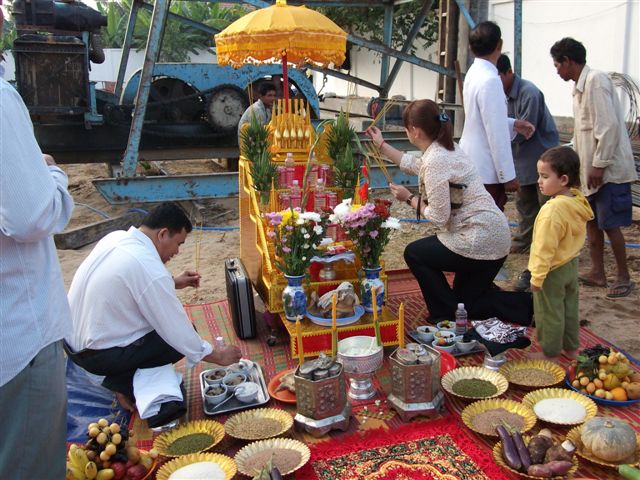Major boost for Eye Clinic, Cambodia

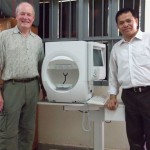
Another successful mission to the Rose Eye Clinic in Phnom Penh, Cambodia, has been completed. Pictured is Rose NZ Trustee Mike Webber and Dr Vra with the Humphrey Field Analyser. All the people in the clinic were absolutely thrilled with the gifted equipment, and could not wait to get taught how to use the gear.
The Rose Charities Eye Clinic in Phnom Penh has just received a major boost, with the arrival of high-tech equipment donated from the New Zealand optom community and a visit from Rose Trustee optometrist Mike Webber with technician Neville Wood.
Three instruments were air-freighted up early this year with the help of one of the Rose team’s guardian angels, Agility Logistics of Lower Hutt. Other benefactors, the PIF Foundation, Peter and Sylvia Aitchison, Sidonia and Adam Pertschy (of Germany ), Mrs Angela Aitken and Mrs Sue Forrest, met the cost of freight and air fares for Mike and Neville.
The three instruments are a Millenium Phaco machine used in cataract surgery, donated by Christchurch’s St Georges Hospital; a Humphrey Field Analyser used for early detection of conditions like glaucoma which cause blindness, donated by the Eye Department, Whanganui Hospital, and an autoclave donated by Alpha Technical Services, of Palmerston North.
As well, a chance encounter with a millionaire “refugee” from New York during the recent visit to Phnom Penh by Rose General Secretary Dr Will Grut has led to a $US17,000 YAG laser being given to the clinic.
The high-level equipment is in the good hands of the medical director Dr Hang Vra, who has just completed his postgraduate ophthalmology exams with top honours, and his wife Nathalie, who is topping her class as she completes her medical degree, having trained as a nurse in the Ukraine.
“Vra and Natalie have both done so well with their studies, while they work so hard for the hundreds of patients who arrive at the clinic every week,” said Mike Webber. “It is really rewarding for them and all the Rose supporters to see the first-class equipment in place.” With these latest instruments the clinic has everything it needs for the foreseeable future.
But changes are afoot. During Mike’s visit an early morning blessing ceremony was held before work begins on a new building that will become both home for Vra and Nathalie and their three sons and a new clinic where paying patients will be treated.
“In Cambodia, you don’t talk about private and public,” says Mike. “It is rich and poor. Vra will earn more money to educate his sons by establishing this new clinic. But he and Nathalie are totally committed to helping the poor as well. I feel confident the balance between their new clinic and the existing one will work out well.
“Things are rapidly changing in Cambodia, and already the city boundary has been extended past the section owned by Nathalie, which is about 15kms north of the present clinic along the main road to Siem Riep.
“So in all I believe that Rose NZ can be proud of what has been achieved over the past six years at the clinic. It is now running splendidly, with
good outcomes for the patients, and I believe that Vra and his team are running the show very well with less input from us as time goes on. They
will still need the occasional input and advice over time, but it wiil get less as their expertise increases. They are all so grateful for all the support from Rose Charities, both from Canada and New Zealand.”
Japan tsunami relief update: 27th March 2011
(2011-03-27) Iwate Prefecture (Kamaishi City and the town of Ohtsuchicho):
1) Ohtsuchicho
The medical infrastructure in the town of Ohtsuchicho was totally devastated due to the torrential tsunami. The clinics and hospitals in the coastal area were all washed away and their doctors and nurses were displaced as well. Hence, they are engaged in relief activities while they themselves are evacuated at the evacuation shelters.
The medical activities in Ohtsuchicho were headed by the staff of the local Ohtsuchi Hospital which also helped AMDA in procuring medical supplies. However, as the hospital had to undergo the suspension of their services until Apr. 15th (for the first time since the tsunami hit; allowing its employees to take some time off to take care of their personal matters), the evacuation shelters under its direction have been facing difficulties in their daily operations.
At Ohtsuchicho High School, due to the lack of coordination, things have been rather confounding as many relief organizations come and go in a short period of time. As of Mar. 24th, teams from AMDA as well as Osaka and Aomori’s medical associations have been active (all comprising a number of staff.) It is also reported that having a pharmacist in the team is very important in providing coherent services as most of the medicines are generic ones.
Majority of patients at Ohtsuchi High School are those with chronic diseases. Therefore, they all requested the medicines they regularly take.
One of AMDA doctors accompanied a local volunteer to deliver mobile clinic services to a remote community in mountainous area where assistance hadn’t reached. In the community where there were about fifty households (most of them elderly) the patients with chronic diseases had been left untreated. Among the patients were diabetes patients with abnormally high blood sugar level or those with excessive high blood pressure. In response to this, the team delivered mobile clinic services on a regular basis.
Contrary to Kamaishi city, the disaster headquarters in Ohtsuchicho has been very much isolated as lines of communication have not yet recovered. The road access to the headquarters is not easy either where the roads are covered by debris.
AMDA team members assume that it is going to take a lot of time to have the medical infrastructure recovered, thus the assistance from external relief organizations is a must. It is also foreseeable that services such as nursing for the elderly would be resumed in the course of recovery.
2) Kamaishi City
Medical volunteers are regularly allocated at the disaster headquarters in Kamaishi City. People are counting on AMDA as its doctors themselves are always present at the daily meeting. Large amount of medicine donated from all around the country has exceeded the capacity of the initial storage so that the stock management has been handful.
Miyagi Pref. (the town of Minamisanriku-cho):
1) Minamisanriku-cho
AMDA has been visiting several evacuation shelters in Minamisanriku-cho on a regular basis, conducting mobile clinic services and on-site needs assessments.
At one iron factory where about thirty people have been evacuated, AMDA prescribed Tamiflu to the evacuees as there were several suspected influenza cases.
According to the surveys conducted in collaboration with other medical teams, following facts were found:
1)There are lots of people who cannot come and collect medicines from the evacuation centers .
2)Depressive symptoms have been increasing among the evacuees.
3)Suspected influenza cases (Tamiflu was prescribed for its prevention.)
4)Along with mobile clinic services delivered by doctors, health care workers are also conducting home-visiting on their own. In order to avoid the overlap, the close communication/referral between the two parties is a must.
A pharmacist from AMDA team sorted out the medicines donated from its donor. The stock management of medicines is considered very important when aid supplies are coming in one after the other.
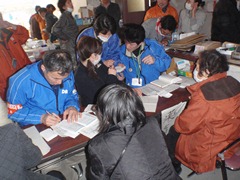 Shizukawa Elementary School:
Shizukawa Elementary School:
Here, it is a local doctor who leads the medical relief, and there are about 50 to 80 patients to the temporary clinic daily. The prescription of medicine is for a maximum of seven days per patient; the doctors decided not to prescribe medicines for a long period if a patient can be cured within a few days. There are also several teams of psychiatrists dropping by in the area.
No gas, water or electricity in the shelter except for the nightly operation of a power generator that helps the evacuees to recharge their mobile phones. LED lights have been provided so the place is not totally darkened out. There are futons but no heating available. On Mar. 24th, the evacuees were able to take a shower for the first time after the disaster struck (40 people at a time every 30mins.)
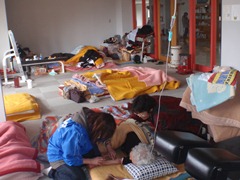 Shizukawa Junior High School:
Shizukawa Junior High School:
Likewise, it is another local doctor that is in charge of the medical relief in the shelter. AMDA helped to deliver mobile clinic services to the vicinity and saw many patients with hey fever and high blood pressure. There were several severe cases such as inguinal hernia and hydrocephalia as well.
Japan tsunami team update: 7th AMDA team now underway..
(2011-03-18) 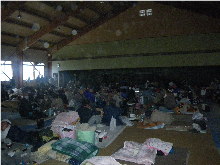 1) AMDA team in Sendai City, Miyagi Prefecture:
1) AMDA team in Sendai City, Miyagi Prefecture:
AMDA team has been delivering mobile clinic services and relief goods to the nursing homes and schools (evacuation shelters) in Aoba and Miyagino Wards. The common cold has become prevalent among the evacuees, however, the prevention is not easy in the crowded evacuation shelters while the dust from the collapsed buildings covering the entire area.
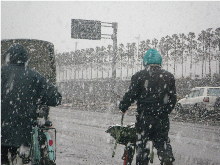 2)Kamaishi City and the Town of Ohzuchicho, Iwate Prefecture:
2)Kamaishi City and the Town of Ohzuchicho, Iwate Prefecture:
Likewise, mobile clinic services have been the main activities of the AMDA team in Iwate Prefecure. The cold weather (snowing) is affecting the evacuees’ health condition and medicine is lacking in the area.
On Mar. 17th, AMDA’s sixth team left for Miyagi/Iwate with medicine and food supplies.
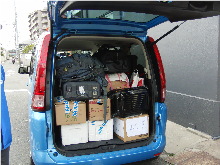 On Mar. 18th, followed by Mar. 19th, AMDA will be sending its seventh team (1 coordinator) and eighth team (1 doctor, 2 nurses, 4 coordinators) respectively to the aforementioned Kamaishi City and the town of Ohzuchicho in Iwate Prefecture.
On Mar. 18th, followed by Mar. 19th, AMDA will be sending its seventh team (1 coordinator) and eighth team (1 doctor, 2 nurses, 4 coordinators) respectively to the aforementioned Kamaishi City and the town of Ohzuchicho in Iwate Prefecture.

